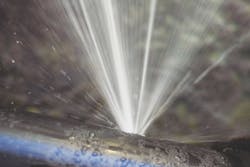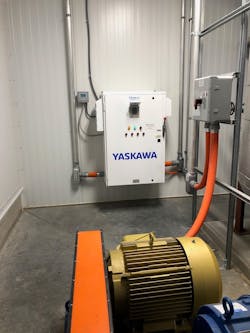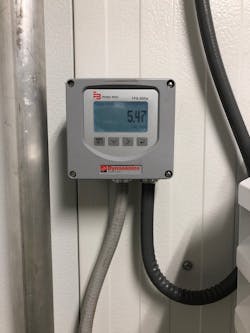Metering: High Pressure, No Problem
Cheryl Ades Anspach is senior product manager of Dynasonics for Badger Meter. Ades Anspach can be reached at [email protected]
undefinedAll food and beverage industry facilities have rigorous cleaning requirements. In addition to food safety, these plants have massive water demands. Further processing facilities require numerous wash-down cycles per day.
High-pressure pumps are a crucial component of plant wash-down systems. The pumps must be consistently operated within manufacturer specifications to ensure utmost performance and reliability to reduce long-term life cycle costs.
Ultrasonic clamp-on flow meter technology can ensure reliable operation of wash-down pumps in food and beverage applications. Employing an ultrasonic transit time clamp-on flow meter paired with a variable frequency drive (VFD) to control wash-down flow rate can save energy and extend equipment life, if done so properly.
Introduction
Manufacturing a food or beverage—as well as maintaining a hygienic work area during the process—involves a significant amount of water. Sanitation and cleaning systems require either raw water or water containing chemicals such as oxidants.
Where food and beverage products are produced, it is often necessary to wash and thoroughly sterilize equipment. However, the machinery utilized in this process typically does not react well to high-pressure or excessive heat. As a result, plant operators must take added measures to ensure every piece of equipment can withstand whatever the cleaning process dishes out.
Using controls to regulate the pressure, temperature and flow in the wash-down system allows plants to save water while cleaning is being done as well as accurately maintain the pressures required at each operator hose. The goal is higher efficiency which, in turn, has a positive impact on the bottom line.
Need for Reliable Operations
Most large food processing plants have pumps in place for their centralized cleaning system. Many of the pump systems are original to the site. These systems often were designed when the plant had less production, and there were fewer concerns with water and energy usage than there are today.
According to a 2018 article in Industry Week, while electricity is the largest energy cost for most food and beverage plants, it often offers the greatest opportunities for savings and delivers the fastest payback.
Food processors are finding ways to conserve water and energy by making adjustments to their current wash-down techniques or implementing new technology. Some facilities have added new pumping resources or switched to larger capacity pumps in their cleaning systems to address increased operational demands.
The current pandemic has underscored the need for enhanced cleaning protocols in the food and beverage industry. Plant operators must implement measures to address the increased sanitation requirements brought on by the COVID-19 outbreak.
In food manufacturing facilities, centralized cleaning systems utilize multiple high-pressure centrifugal pumps, which are staged off and on based on demand. There is less demand for pump capacity during the day and greater demand later on during the cleaning and sanitation shift. Every pump in the system runs at full flow and pressure when the plant is at peak sanitation. The pumps are shed as the cleaning process is completed.
The first step in optimizing wash-down system performance is to operate the fewest pumps required as load is reduced. This increases the flow per pump and is the most effective, easiest and least expensive corrective measure. Operating fewer pumps will normally result in running each pump closer to its best efficiency point (BEP), consuming less power.
In operations, such as meat and poultry processing, plant personnel try different methods to protect high-pressure centrifugal pumps from hazardous low-flow conditions. If the pumps have too little flow for an extended period of time while the motor is running at full speed, excessive wear and internal damage can occur. Although the pump installation often includes a small bypass line, operating in a low-flow condition can result in complete failure.
Importance of Flow Protection
For companies in the food and beverage industry, a key requirement is staging wash-down pumping equipment based on variable demand. This is typically accomplished by monitoring pressure and flow rate in the system. It is important to maintain a minimum pressure, but if the flow drops below a certain threshold, it may be advantageous to start shedding pumps from the plant’s hot and cold water resources.
Flow meters are commonly used to stage pumps off, since it is difficult to determine the right time to begin pump shedding based on pressure readings alone. They also assist with putting pumps to “sleep” at certain intervals to save energy and minimize excessive wear and tear. The meters provide a milliamp signal back to the VFD to initiate this action.
Facility operators cannot afford to take chances with pumps and other expensive circulating equipment used in wash-down applications. Determination of a pump’s minimum flow rate must be taken seriously, and a reliable system should be incorporated with every new pump installation. Some plant operators install pressure sensors and use the readings from these devices as an input for pump controls. However, this method is problematic in most applications.
Understanding the causes and effects of minimum flow damage in centrifugal wash-down pumps is critical for knowing how to prevent it. Minimum continuous safe flow is the flow at which a pump can operate continuously without excessive wear from hydraulic anomalies and temperature rise associated with low-flow conditions.
At reduced flow, pumps can experience a flow reversal where the fluid turns and flows back upstream. This results in internal recirculation, which is often referred to as suction recirculation, and subsequent heat buildup. Internal recirculation occurs at reduced flow rates when more liquid approaches the eye of the impeller than can pass through the pump.
All of these factors contribute to the need for a pump control solution designed to provide variable flow for pump staging and shedding. This is particularly important during periods such as mid-shift wash down, which involves specific cleaning regimens for plant equipment. Pumps and drives must automatically activate as part of the sanitation process.
Choosing the Right Solution
Food and beverage industry users choosing flow meters to control the operation of high-pressure wash-down systems must consider key factors to make the right decision. There are significant differences between meter designs with each type of device having its own pros and cons.
Since the outlet pressure of wash-down pumps is fairly high with hot temperatures, ultrasonic transit time clamp-on flow meters can serve as an alternative to electromagnetic flow meters. These in-line devices require a system shutdown—a high cost outcome—for installation. Ultrasonic clamp-on flow meters, on the other hand, can be retrofitted to existing piping systems and deployed while pumps remain in operation.
Ultrasonic transit time technology is also a better option than low-cost orifice plates, which cause a permanent pressure drop in the system. Ultrasonic meters provide a high turndown ratio over the full operating range of wash-down and cleaning and sanitation pumps.
Ultrasonic transit time flow meters measure flow rate by propagating ultrasound waves into liquid-filled pipes and measuring the time of flight. With clamp-on technology, the meter is non-intrusive, which provides key advantages, including:
- Reduced installation costs;
- Uninterrupted production;
- Installation flexibility across a wide range of pipe sizes;
- No pressure head loss;
- No contact with internal liquid;
- No moving parts to maintain; and
- Routine maintenance without the need to cut into piping.
Ultrasonic clamp-on flow meters are an effective solution for measuring volumetric flow rates in clean liquids as well as liquids with small amounts of suspended solids. The meters are available in a variety of configurations to meet particular application requirements and include helpful diagnostics to take the guesswork out of programming.
Depending on programming and integration into a programmable logic controller (PLC), users can be alerted to out-of-specification flow conditions and access a history of recent alarms, error and event codes. In some cases, the flow meters support an encoder output for use with cellular endpoints for connecting to advanced metering analytics (AMA) cloud-based software. This software can collect measurements to help with tracking and analyzing water usage information. Some manufacturers include an integral datalogger as a standard feature to store and access historical data.
Application in Food & Beverage Facilities
Food and beverage plants have found success using a pump control package consisting of an ultrasonic transit time flow meter that provides flow rate information to a VFD. This can prevent wash-down pumps from running with too little flow for an extended period of time as well as staging a second pump during high-demand situations. It controls pump operation to closely match system demand to save energy costs.
Within the pump control package, a duplex VFD panel and a single ultrasonic flow meter work in tandem to control the pump speed and run time. In automatic mode, the master pump will run at the selected speed to meet desired pressure until the flow meter has signaled a low-flow condition, which will slow the pump to a minimum speed or stop the system entirely. If the flow meter signals a high-flow condition, a second pump will be started to meet demand. If the flow decreases for a length of time, the second pump will turn off and the master pump will continue to operate.
Whether the washdown system is operating at full capacity or as the system requirements are reduced, the pump, flow meter and VFD can adjust the volumes to meet the required pressure and flows. The system maintains the pressures when the cleaning operation is in process by adjusting motor speeds and starting additional pumps as required to keep the flows and pressures constant. It also allows for the predetermined time allotment as this occurs.
Benefits to Plant Operators
Protecting investments in pump system assets can greatly influence profitability through improved reliability, fewer equipment replacements, a decrease in pump reconditioning expenses, reduced energy costs, and less disruption in production activities.
In sanitary wash-down systems, ultrasonic transit time clamp-on flow meters enable improved diagnostics to accurately measure flow, help identify potential pump operating issues and initiate appropriate preventative maintenance programs, thus extending the life of assets while reducing long-term cost of ownership.
Plant operators have seen that an ultrasonic flow measurement solution with a VFD to control wash-down flow rate and automated pump start-up and shut-down also helps reduce energy consumption. Using controls to regulate the volume and pressure in the wash down system also allows plants to save water during cleaning while accurately maintaining the pressures required at each operator hose. Taking these steps can result in higher efficiency, creating a positive impact on the bottom line.
By helping to optimize wash-down procedures, an effective flow measurement solution enables food and beverage companies to meet the challenges associated with global health and pandemic concerns. Plants implementing rigorous, World Health Organization (WHO)-recommended sanitation cycles place tremendous demands on pumping systems due to increased pressure and temperature levels during disinfecting and rinsing.
Conclusion
Minimizing waste and reducing the cost of utilities while ensuring highest product quality is a challenge in the food and beverage industry. The ability to maximize efficiency during cleaning and sanitization processes while ensuring the health and safety of consumers is essential.
For food processing operations, the use of a modern control package for high-pressure wash-down systems enables plant personnel to spend more time meeting production demands and less time worrying about equipment.
A flow measurement solution combining ultrasonic transit time clamp-on flow meters and VFD technology can provide a quick return on investment. This solution allows the wash-down system to achieve minimum flow rates or completely shut off when demand is low without the potential for severe equipment damage.


